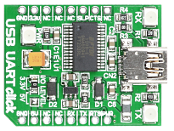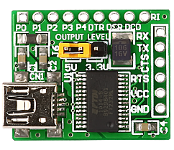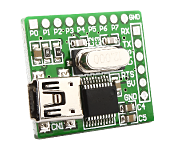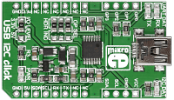|
|
| |
|
 | Search: |
|
|
 |

|
|
FTDI Click features the FT2232H dual high speed USB 2.0 to UART/I2C/SPI serial interface converter. It includes a DA converter and EEPROM as well. The entire USB protocol is handled on the chip (FTDI USB drivers are required), making this board ideal for various USB applications. FTDI Click communicates with the target board via mikroBUS SPI (MOSI, MISO, SCK, CS), I2C (SDA, SCL), UART (Tx, Rx), RST, PWM, AN and INT lines. The board can be powered via USB or via mikroBUS socket. A green LED indicates the presence of power supply. |
|
|
|
|
 |

|
|
USB UART Click is an accessory board in the mikroBUS form factor. It is a compact and easy solution for adding serial UART communication via USB to your project. It features the FT232RL USB-to-UART interface module as well as a USB MINI B connector. The board is powered with 5V, but is designed to use 3.3V or 5V I/O levels (selectable via an SMD jumper). The board also features power, Rx and Tx LEDs. |
|
|
|
 |

|
|
USB SPI Click is an accessory board in the mikroBUS form factor. It is a compact and easy solution for adding SPI serial communication via USB. It features the MCP2210 USB-to-SPI protocol converter with GPIO as well as USB MINI B connector. USB SPI click communicates with target board via SPI interface as a master device. An SMD jumper is available for selecting whether board will be operating on a 3.3V or 5V power supply. |
|
|
|
 |

|
|
The USB UART Board features a USB to serial UART interface FT232R that simplifies USB to serial designs and reduces external component count by fully integrating an external EEPROM, USB termination resistors and a clock circuit requiring no external crystal, into the device. |
|
|
|
 |

|
|
The USB UART 2 Board is a prototype board that features a USB-to-UART serial converter MCP2200 which enables USB connectivity for prototype devices that have a UART interface. The board also features a USB Connector. |
|
|
|
 |

|
|
USB I2C click carries an MCP2221 USB-to-UART/I2C converter. The chip supports full-speed USB (12 Mb/s), I2C with up to 400 kHz clock rates and UART baud rates between 300 and 115200. The board communicates with the target MCU through mikroBUS UART (RX, TX) or I2C (SCL, SDA) interfaces. In addition to mikroBUS, the edges of the board are lined with additional GPIO and I2C pins. It can operate on 3.3V or 5V logic levels. |
|
|
|
 |
|
|

